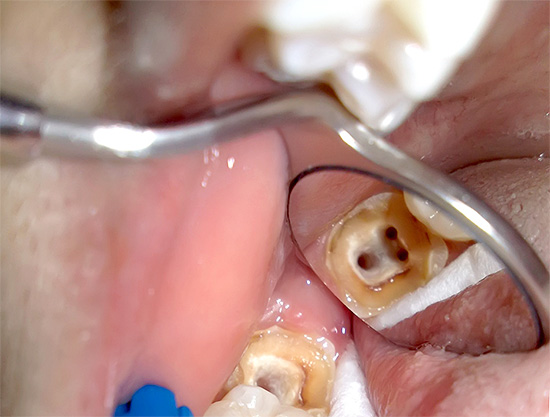
First of all, we note that the price of treating pulpitis of a three-channel tooth really depends on the number of these root canals in it, and here the general rule is this: the more there are, the more expensive the treatment procedure is. And not only more expensive, but, in addition, with a large number of roots, a number of nuances of endodontic procedures often arise, which we will talk about in more detail later.
On a note
Pulpitis Is a disease in which inflammation of the so-called dental "nerve" (pulp) occurs. Large molars (molars) most often have three channels, in each of which there is a neurovascular bundle. When an inflammatory process occurs in the pulp, it swells and squeezes, as a result of which a person can feel severe pain.
Pulpitis requires compulsory treatment: you should not expect that everything will somehow resolve, and the pain will go away on its own, as is sometimes the case with pain with caries. The pain can really disappear when the "nerve" completely dies, but then it starts to decompose right inside the tooth, and without appropriate treatment it will not lead to anything good.
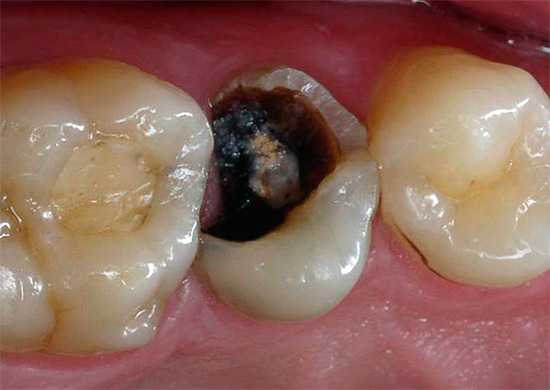
The treatment of pulpitis of a three-channel tooth, unlike a single-channel tooth, is most often technically more difficult, therefore, a doctor has to spend more time and effort to carry out quality work, as well as actively apply the achievements of modern dentistry.
Today, in most clinics, three-channel pulpitis is almost always treated by extirpation - nerve extraction from all channels and their filling at the final stage of intracanal treatment.
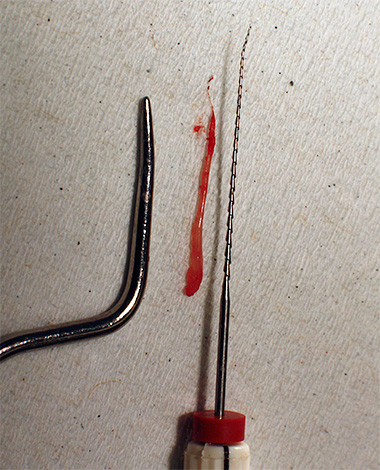
It is interesting
In the upper teeth of wisdom, there are the most unpredictable options for the number and location of roots and channels. As a rule, doctors encounter one-, two- and three-channel eighth teeth, but there were also cases of 4 and even 5-molar teeth with up to 8 full channels in it!
The main stages of the treatment of three-channel pulpitis
Three-channel pulpitis in most dental clinics is treated in two visits. The technique of the so-called vital extirpation is well suited for these purposes, when under local anesthesia the pulp is removed from all three channels and filled with subsequent placement of temporary filling material on the tooth. And on the second visit, a permanent seal is safely established.
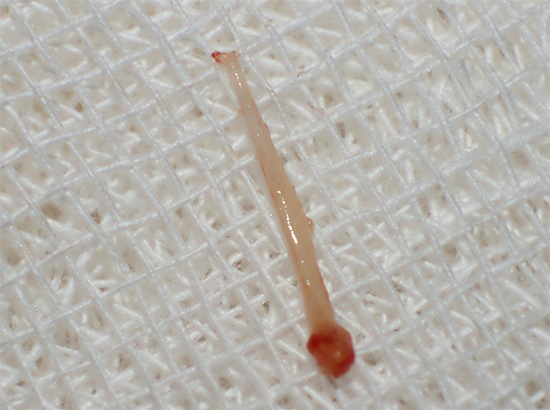
Let's now see how this happens in practice.
First visit:
- tooth anesthesia;
- preparation of carious soft tissues with a turbine tip, removal of necrotic and pigmented dentin;

- washing with antiseptics;
- opening good access to the mouths of the three channels;
- mouth extension;
- Cofferdam overlay

- extirpation (extraction) of pulp from all three channels by pulp extractors;
- passage of channels by files, measurement of their length, expansion by K-files, H-files, machine tools with constant irrigation (washing) of the channel system with sodium hypochlorite solution;
- the use of EDTA for poorly passable canals;
- drying of channels, control measurement of their lengths;
- filling the channels by cold lateral condensation of gutta-percha pins with paste or using the Thermafil system for obturation;
- staging a temporary filling or temporary restoration of a tooth;
- control picture (x-ray).
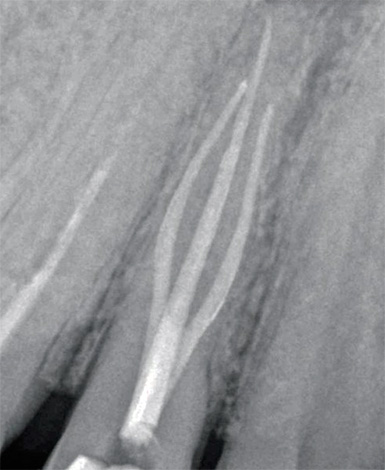
Second visit:
- tooth retreatment;
- Setting a permanent seal from a light-cured composite or other imported material (an example will be shown in the photo below).
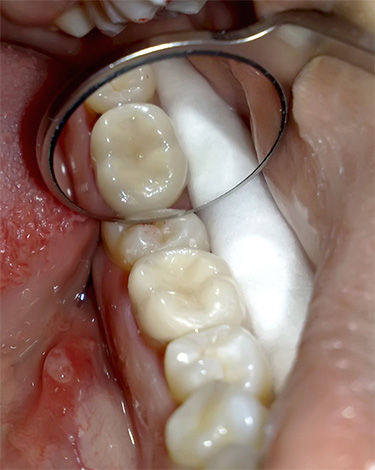
Sometimes pulpitis of a three-root tooth is treated in three visits and even more. It depends on the chosen methodology, the tactics of the doctor, the level of his professional skills and sometimes difficulties arising during intracanal treatment.
If it is impossible to immediately remove the pulp from the canals, the dentist puts a devitalizing preparation on the opened pulp chamber in order to “kill the nerve” for the next appointment. Accordingly, this increases the treatment of three-channel pulpitis by one visit.
In Soviet times, even arsenic was put on arsenic for a period of 24 hours. Such practice at the current level of development of dentistry is already unacceptable. Pulpitis treatment of a single-channel tooth, as well as a two-channel tooth, is almost always carried out in one visit (with rare exceptions).
Large molars (mainly lower) due to structural features of the jaw and the location of the nerves that determine tooth sensitivity can sometimes not be “frozen” to the extent that the nerve can be removed immediately, that is, the pain sensitivity remains. Therefore, the way out of this situation is precisely the preliminary use of killing pulp pastes (in the people they are still called "arsenic", although modern drugs have long been free of arsenic).
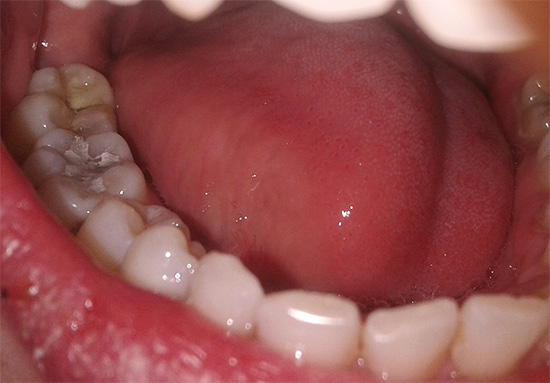
On a note
In a number of clinics pulpitis treatment it is always carried out in one visit, and regardless of the number of channels: they are sealed, and a permanent filling is immediately established on the tooth. Studies have shown that often this practice leads to long-term negative consequences, since the material introduced into the channels must first harden. They do not start work in construction until the foundation hardens, since the consequences can be disastrous - and here the situation is the same. That is why it is recommended to treat pulpitis in at least two visits.
The use of a microscope in the treatment of pulpitis
A microscope in endodontics is used, in particular, to diagnose the number of root canals and the quality of their passage. Treatment of pulpitis of a three-root tooth under a microscope allows you to quickly find and treat even the most difficult passages, and there are many such cases in the practice of a dentist.
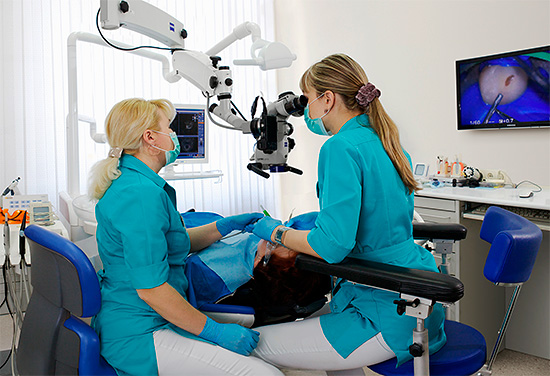
An endodontic microscope allows with almost 100% certainty to say at the end of the treatment that all the channels have been passed and properly sealed. It is he who allows you to control every stage of pulpitis treatment, preventing further complications. Traditional treatment without the use of a microscope is often associated with the presence of long-term negative consequences, for example, due to the fact that the doctor simply could not see the additional channel in the tooth and missed it during treatment, leaving an infected pulp in it.
Sometimes, in the treatment of pulpitis, the doctor finds 3 channels, but in reality there is a 4th (or even a fifth) “well hidden” in the tooth. There are cases of missing not one channel, but several, as there are complex options for their location in the tooth.
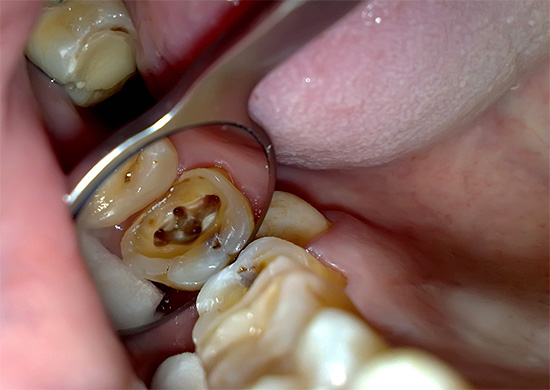
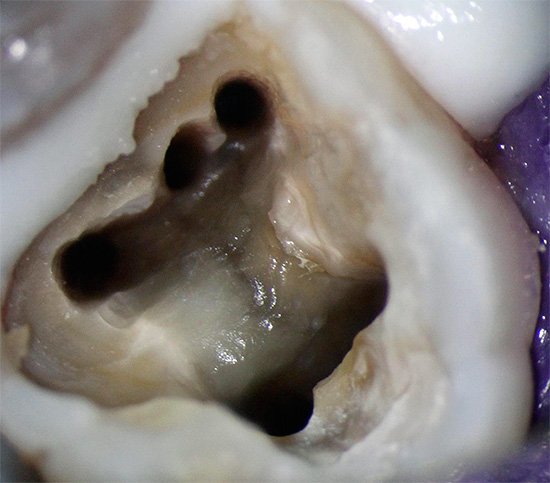
It is interesting
For the treatment of canals, the microscope was first used recently - in the USA (1992). A modern endodontic microscope allows you to treat teeth under magnification of almost 30 times. During the procedure, the doctor looks through the eyepiece of the microscope and performs complex manipulations in the canals. A video camera can be connected to the microscope, allowing you to transfer the image to the monitor. At the same time, the doctor is not too close to the patient, since the microscope helps to treat the tooth somewhat remotely, which satisfies those patients who do not like to get into their personal space. This treatment is considered one of the most advanced in the world.
The high price for the treatment of pulpitis of a three-channel tooth can scare away patients even with a normal income, since there may be two or even three times more than the traditional treatment option (and imagine how things were with the treatment of pulpitis of a four-channel tooth). However, such an increased price is often quite justified given the specifics of a complex and lengthy endodontic treatment, so do not immediately think that they are trying to fool you and lure money.
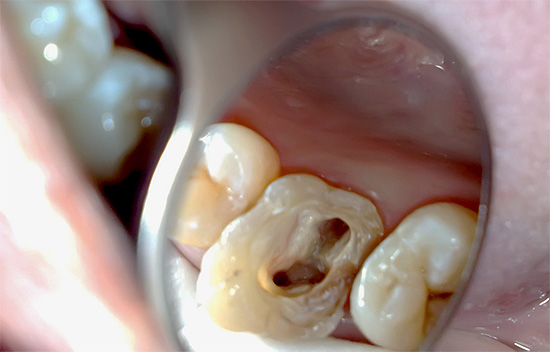
What is the price for the treatment of three-channel pulpitis?
First of all, we note a characteristic point regarding the pricing policy of most clinics for the treatment of pulpitis - the cost depends on each channel found in the tooth. The fact is that each channel is an additional laborious work of a doctor and additional costs of materials.
For example, in a person’s tooth, instead of one channel, they may have three, four or more. Therefore, it is not difficult to guess that the price for the treatment of three-channel or four-channel pulpitis consists primarily of the amount of work performed by the doctor: passage of channels, their irrigation (flushing), expansion, filling ...
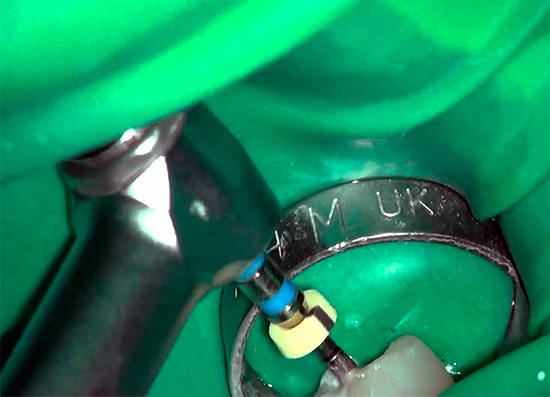
Pulpitis treatment cost also includes:
- Local anesthesia;
- Additional hardware methods for monitoring and treating canals: apexlocation (determination of length), X-ray examination, ultrasound or laser treatment, irrigation, the use of a microscope, placement of temporary medicines under a dressing in channels, etc.
- Permanent filling material. After filling the canal on the next visit, the doctor establishes that permanent filling, which the patient chooses, focusing on an acceptable price for him.
With this in mind, it becomes quite obvious that regardless of the dental institution the patient is contacting for help, treatment of pulpitis of a single-channel tooth will cost much less than a three-channel one.
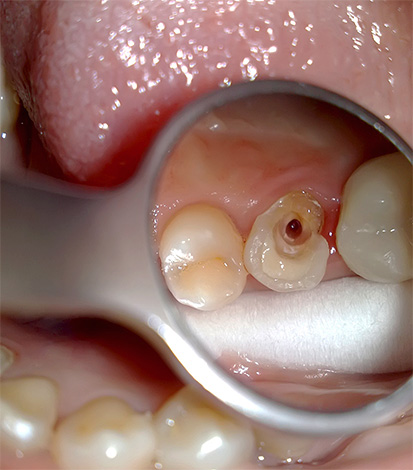
It is interesting
One channel in 100% of cases is present in the upper incisors and canines. Moreover, in canines, most often the canal is very wide and long. In the lower incisors, there is mainly one channel, but two are often found. The lower canine is only 6-channel in 6% of cases, and single-channel in the rest. The second premolar (5 upper and lower teeth) in more than 70-80% of cases have one channel.
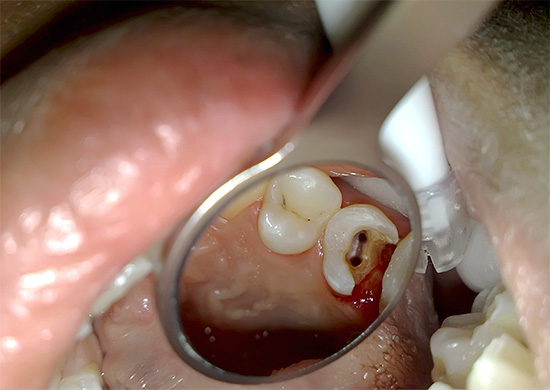
Different clinics - different cost of services: what exactly do you pay money for?
Depending on the “price-quality” indicator for the services provided, all dentistry can be conditionally divided into three categories:
- Budget organizations (clinics, hospitals);
- Private clinics of economy class;
- Private business class clinics.
Benefits of a budget organization:
- Free treatment or low price for services (as a rule, only the cost of paid materials is taken into account);
- You do not need to sit in a chair for a long time, as quickly as possible.
Minuses:
- In general, the relatively poor quality of services due to the constant rush of the doctor, lack of technical equipment, lack of materials and often the professionalism of the dentist himself.
- Long waiting times in lines, where you can often hear such that any desire to go to the doctor disappears.

- Rudeness and bad attitude towards the patient is, unfortunately, not uncommon in many clinics and hospitals.
- There is no guarantee for the treatment of the canals and for a permanent seal.
As a result of poor-quality treatment of three-channel pulpitis in a budgetary organization, the following problems may arise in a short time:
- tooth pain on the background of poorly washed, incomplete canals or due to the removal of filling material outside the root (it will hurt to bite);
- swelling of the gums and cheeks with missed canals (with infection), or a fragment of a dental instrument left in the canal, which is also not uncommon (see photo below);
and etc.
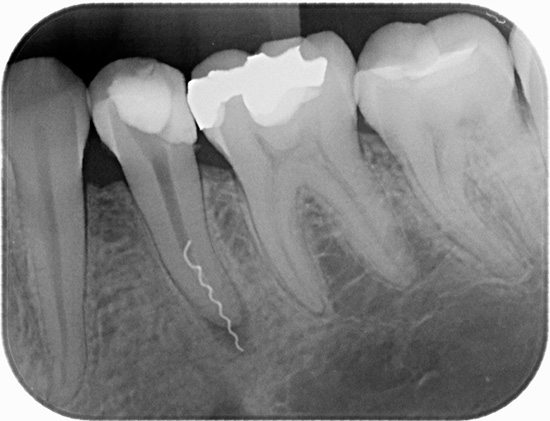
The mistakes of a budget doctor can be listed endlessly, but it is worth remembering that there are many doctors even in hospitals and polyclinics that are provided with material and have a high level of professional qualities that allow treating at least three, at least four-channel pulpitis at a fairly high level, although today it is rather an exception to the rule.
Benefits of a private economy-class clinic:
- Availability of services for the middle-income population;
- Lack of large lines;
- As a rule, a fairly high professional level of the doctor;
- Availability of necessary equipment and materials for the implementation of economy class services;
- Warranty for canal treatment and filling.
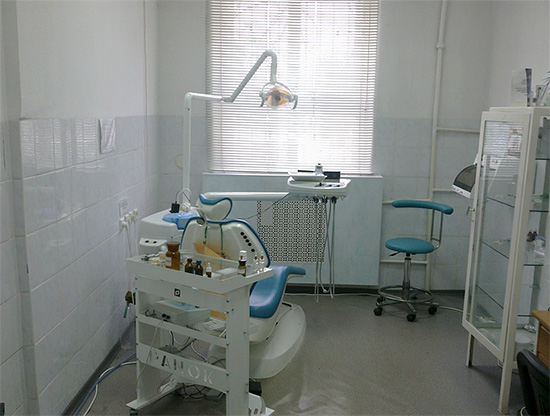
Minuses:
- Lack of maximum quality control of treatment at all stages (the risk of complications after filling the canals can be described as average);
- Materials that are not good enough for artistic restoration, which often do not allow making the seal completely invisible to the eyes of others.
A private business-class clinic, unlike previous options, allows you to provide very high-quality services thanks to the availability of modern equipment and the high training of qualified dentists.

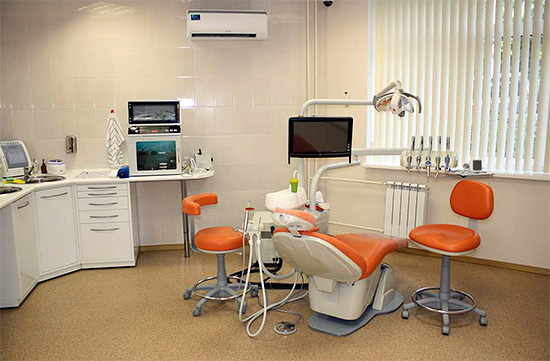
The use of a microscope, as an intermediary between a doctor and a patient’s tooth, significantly increases the already considerable price for the treatment of pulpitis of a three-channel tooth. However, thanks to such equipment, the patient can forget for the whole time that treatment was once carried out in the channels of his tooth, and he will only have to come to the dentist sometimes to examine the condition of the filling.
Often there are situations when a patient, turning to a local clinic, loses a tooth in a year or two due to developed at the root of the cystand, as a result, carries out an expensive prosthetics of an absent tooth at a price even higher than the treatment of three-channel pulpitis, but already in a business-class clinic.
There are also cases when, for example, 5-7 years after the treatment of pulpitis in an economy-class clinic (for about 6-7 thousand rubles), it is discovered that a huge granuloma developed on the root against the background of the instrument fragment left in the canal, due to which tooth to preserve is not possible. In such a situation, it’s already difficult to say for the patient what is better for him: to lose a tooth in 5-7 years and engage in expensive prosthetics or implantationor go to a business-class clinic right away, where treatment of pulpitis of a three-channel tooth will cost around 12-14 thousand rubles, but such a tooth will last almost the rest of its life.
Interesting video: treatment of pulpitis of the upper tooth, which turned out to be not three-channel, but 4
And here you can see all the stages of pulpitis treatment, including filling

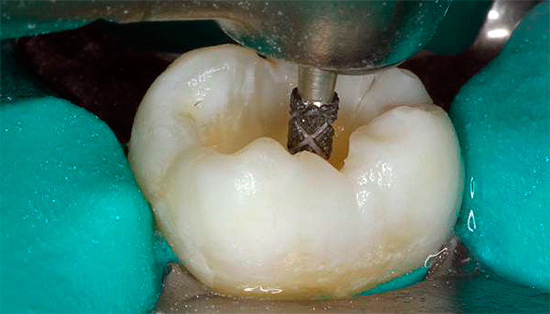
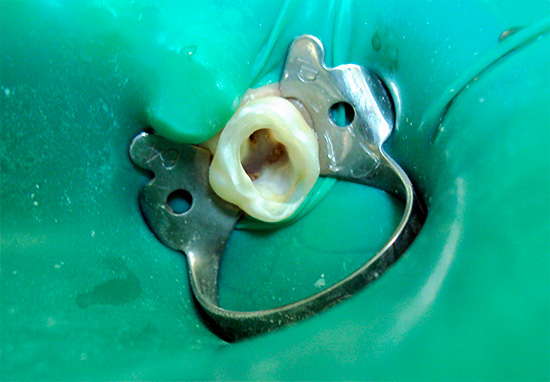

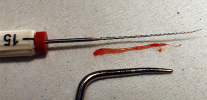
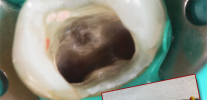
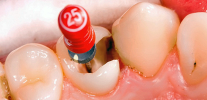
Good article. From my own experience I was convinced that it is better to go to a good private clinic to treat a tooth and forget about it.
The procedure you described (first visit) was made to me without a rubber dam. Burned under the tongue, there are white spots.Tongue does not turn - it hurts. Passed on mashed potatoes and semolina. You have no such error in the articles. Will this injury heal?
Hello! You give little information about the treatment, but it can be assumed that the burn was caused by washing the channels with sodium hypochlorite and getting a large amount of the solution on the mucous membrane. A hint of cofferdams suggests this is exactly what. Although the dentist could damage the mucous membrane with other drugs used in the work. The article does not stipulate such a problem, since it is not so common. In principle, you still need to look in the oral cavity, communicate with you, sometimes it is even important to know how and how doctors work in this clinic. Judging by the correspondence description, you have ulcers on the background of "injury". Whether it is a burn or not, it is all decided on the spot. I think that the dentist who gave you the treatment should answer questions about the complication and prescribe anti-inflammatory, wound healing and symptomatic treatment. I can’t register anything specific via the Internet. In general terms, I will say that wounds in the mouth (especially of a traumatic nature) heal quickly and well. Most often, even without the help of a doctor (but in this case, it takes a little longer to return to a comfortable life).
Thanks for the answer. I was treated with periodontitis, cleaned the canals. By the second visit to the doctor (in a week) almost everything had passed. But this week I had to suffer and visit your site (and not only) to understand what happened. She told the doctor at the second appointment about the damaged tissue, she said she would be more attentive. The promise was kept, another pulpitis was cured. But bleaching powder in dentistry is, of course, tin! Thank you again for your careful attention to other people's problems.
Hello, tell me, please! I had a sore tooth 16, was in a private clinic, they cleaned the canals, filled the canals with medicine and put a temporary seal. The doctor warned that a tooth will ache for 2 days, and prescribed me a nimesil, then the tooth will pass. Yes, he ached with me very strongly for 2 days, then, as the doctor said, the pain went away ... But from the cheek's side the gum was swollen, such a tubercle. I called, I was at the doctor again, he took the picture again, said that everything was fine. Prescribed an antibiotic and said what should pass. But today she got up - the tooth does not bother at all, but as if the gum was swollen even more and it hurts only in that place. Tell me, please, is this really normal and will pass? Or what to do?
Hello! Yes, this is not the norm, since we are talking either about insufficient processing of the channels, or about technical violations in the process of endodontics. I would not want to delve into the intricacies of canal therapy: an educational program for dentists or a master class on periodontitis (relatively difficult to treat the diagnosis) is conducted by the best specialists in the world for 2-3 or more hours (usually a whole day), where each component of treatment has the meaning. This is a kind of building blocks of the future home, if something goes wrong, then the whole building collapses.
Here are some points to consider:
1. Not all teeth with periodontitis can be cured;
2. Those teeth that can be cured with periodontitis, not all dentists can bring to mind that the patient was comfortable at the stage of treatment, and there was the prospect of preserving the tooth for a long period (more than 15-20 years);
3. A number of dentists, out of ignorance or in certain circumstances (poor equipment), either take not very promising treatment (when there are indications for removal), or conduct treatment of canals with gross violations, relying on antibiotics and painkillers, with the clear intention of turning all this into “Chronic” form, when, in principle, nothing hurts, but the inflammatory focus behind the apex of the root or roots increases in size every week, month and year.
I sincerely did not want you to continue to be within the framework of the successive points I have cited. It would be useful to contact another dentist and find out whether the work was done qualitatively or not.
Guys, help me figure it out. 12/10/16 went to the dentist.It seems a trivial matter - to put a seal on a tooth that 7.12 broke by eating nuts. I did it, tormented me for a long time and tediously, as a result, I already come 12.12 with pains and an uncomfortable bite, they grind my tooth under the form, the upper one too (!). They are treated with fluorine and sent home. I come in a week with complaints: pain, all this time I can’t eat anything serious, baby purees and that's it! They say that the tooth heals and is again treated with some kind of magical means ... And now, already angry, I am returning on 12/26 (there were no closer records). A consultation is going on, the tooth is remade first, and the pains are wild. Under anesthesia, it seems to be easier. But on the threshold of 30.12, and I again with them, they give me a special paste and say that if it doesn’t work, then 4.01.17 come to depulp ...
As a result, they removed the nerves, paid 20 thousand rubles. They said that everything will be whining, but it hurts, very much! The temporary shelter fell off, although she ate after 3 hours, and porridge, so that nothing would interfere with healing. The pains are wild, but the worst thing is that when I touch my tooth, the gum hurts, I bite something - it hurts. Swells. An injection of flamax, ketorol and spasmalgon has already been launched, so that at least something takes - zero. I am writing to you, it hurts and offends. What to do? How to hold a doctor accountable? I'm tired of paying money for mistakes, because I was going to treat a tooth, but in the end I lost it. If there is a removal ahead, then I do not know what I will do.
Hello! Even without additional diagnostics, there is a feeling that money is simply being pulled out of you. A normal doctor, even with certain difficulties, finds a compromise in this matter, and you are clearly “undressed”. It would be nice to check the tooth from the picture and have some strong evidence of errors in the treatment of canals. This chain of problems is rarely random. You can prove anything by checks, job guarantees and work analysis by an independent commission. There is a medical commission that assesses the work done and seeks out complications that depend or not (rarely) on the attending physician. If, for the sake of principle, you want to start such a disassembly, then this is completely justified. As for the payment of legal costs - you yourself know that it is often possible to win only mentally, but not materially. If you want to come from this direction, then you need to prove the mistakes of doctors as soon as possible, and then urgently treat the tooth with other specialists, and ideally, the clinic that “screwed up” the tooth should pay for new checks (payments).
Today, he also treated pulpitis - the doctor also said a decent price at first, I did not count on it, I thought it was a hoax - we always think so. But it turns out, yes, there is something to pay for - I removed the 3 nerves, cleared the moves, put a temporary seal and sent it until Tuesday. What is interesting, when he was cleaning one of the moves, he felt as though he had driven all the pain further inward. And I don’t know, maybe because of this, but there is discomfort in the eye. This is normal? Or is it just a post-stress state in the nerves?
Hello! Such sensations could arise both against the background of post-filling pain, and against the background of any mistakes of the dentist. In general, I can say that you have a somewhat "strange" symptom, in my opinion. You can verify that it can actually be by taking a picture of the treated tooth canals - you can send it to the site’s mail, I will comment on the quality of the treatment.
Thanks for the answer! Fortunately, everything went in a week, or even less. All the discomfort that was gone. Such happiness when teeth do not hurt)
P.S. Great article, lots of pictures + feedback. You are a big plus! Good luck and health!
Hello, can there be two channels in the 37th tooth? If two channels were sealed to me, the third was not found, can the tooth hurt in the future? I was told that I can safely pass two years.
Hello! Two years is because there are 2 channels in a tooth, and if there were three, then 3 years would pass? 🙂
According to what you were told, one of two conclusions can be drawn: either the doctor himself is not sure of his work, or you are so obsessed with the doctor that he simply named a more or less acceptable figure as a possible answer.
In the 37th tooth, most often there are 3 channels (about 75% of cases), 2 channels are a little less frequent, very rarely - 1 and 4 channels. So you should take a picture of the tooth in different projections so that there are no problems in the future.
Good afternoon. A tooth really hurts, I don’t even know which one is stronger. Below is a bridge of six teeth, the picture shows that only one channel is sealed, and the rest are not. Top hurts or seven, or eight. The doctor can not decide on the tactics of treatment, please help.
Hello! The fact is that in such a situation it is problematic to render assistance in finding a diseased tooth in absentia. Initially, it’s advisable for you to go to the clinic for an appointment with another dentist along with the pictures (since your doctor does not know what to do). It is possible that not only image analysis will be needed, but also EDI - electroodontodiagnosis. In general, the search for a diseased tooth is often not easy, everything is decided in the dentist’s chair. So it’s more like an appointment with an experienced doctor in a clinic with good equipment!
Hello, in the morning they removed the nerve and cleaned the canals on the lower 6-ke, put a temporary seal. They did good anesthesia, did not feel pain in practice. After the effect of anesthesia passed (after 3-4 hours), the tooth began to hurt, aching constant pain, it hurts all day. And they recorded a permanent seal after almost 2 weeks, is this normal and will the temporary seal disappear over these days? And why does the tooth hurt so much?
Hello! If you gave a link to a tooth picture, then I could say more about the quality of the treatment carried out in the channels. But in general, biting pains often occur after endodontics, which is largely due to the traumatic nature of endodontic measures - starting from the treatment of the canals with “needles” and ending with their filling with filling material beyond the root apex. Therefore, how promising the work done by the doctor can be said only on the basis of the picture.
The fact that they recorded a permanent seal only after 2 weeks is not very good. If you have undergone a temporary restoration (which I doubt), then 2 weeks you could wait. But if the tooth was closed with a classic temporary filling, then it often does not provide tightness for a period of more than a week. I would recommend placing the tooth with a permanent filling earlier - of course, after checking the tooth from the picture for the quality of obturation of the canals. A temporary seal in two weeks can break off or even fall out, and negative consequences can occur even with an invisible eye depressurization of temporary material.
Hello. Three foci of pus were found in the tooth on each canal. The doctor openly hints that it is better to remove, because the tooth is complex and problems can arise later, because without the pulp the focus of pus will manifest itself only at the very last moment. What do you think about this?
Hello! In addition to formal indications for the preservation or removal of a tooth, the authoritative opinion of the attending physician is also important (much depends on his experience and the availability of equipment at his workplace). Yes, in your situation, the tooth can be completely removed, but I recommend taking into account the fact that most of the most complex forms of periodontitis can be treated conservatively today, and some part can be treated conservatively (for example, by resection of the root apex with a cyst) . If your doctor doubts the possibility of saving the tooth, it is useful to get an opinion from other specialists.
Interestingly, if you get advice on the fate of the tooth in another 2-3 clinics, you can get diametrically opposed points of view. It is worth relying on various factors:
1.By the number of coinciding logical and sound arguments of the doctor: the more “FOR” some decision, the more likely it is necessary to listen;
2. At the level of the clinic, the experience of the doctor and his qualifications. If you have data (from relatives, friends, acquaintances) that in this dentistry there is a doctor who saves the most hopeless cases, undertakes to treat complex teeth, then perhaps you should trust him.
If you ask me personally about my opinion on your case, then without seeing your picture and tooth in the oral cavity, as well as without knowing many other important points, I cannot tell you something unambiguously. However, before you decide to remove the tooth, I recommend that you receive face-to-face consultation with specialists even in at least 2 clinics of a sufficiently high level (usually there is everything necessary for the management of complex cases).
Hello. The tooth didn’t hurt, it feels cold and hot, it’s broken off deeply. The doctor drilled the whole tooth - "canals, small canals, deep gone." He says that it is necessary to treat all the channels, but the nerve must not be removed, he said. I’m sitting here waiting for a week and a half of the next appointment, with a temporary seal and brown paste under it. There was still no pain. Tell me, please, what is the difference between channel treatment and nerve removal, and what is the sequence? A lot of sites, a lot of scribble, everything is somehow mixed up, I feel some kind of catch, but I can’t figure it out.
Hello! There is no catch, there are different diagnoses: pulpitis and periodontitis. With pulpitis, it is necessary to remove the "nerve" and fill the canals (most often in one visit), and with periodontitis, there is no longer a "nerve" as such - even if it is present, it can be decomposed, and it can be called a "nerve" only a big stretch. Therefore, the doctor told you that “nerves” will not have to be removed, but the treatment of the canals with periodontitis is extremely important, since the fate of the tooth with the future filling depends on it.
Since I don’t know the severity of the inflammatory process behind the tops of the roots in your case, I can’t tell if long walk with a temporary filling and the drug under it is adequate in the current situation. Today they are trying to minimize the period of application of the paste, placing more emphasis on the thorough processing (washing) of the channels. A number of dentists generally abandoned pastes for medical dressings in canals in favor of high-quality processing and tight obturation of canals with modern materials in one visit.
As for the sequence: with pulpitis, the “nerve" is first removed, and then after processing the canals they are sealed. With periodontitis, it comes down to perfect cleaning of the canals and subsequent filling.
Hello! I had a three-channel tooth, the nerve was removed and the channels were sealed. The doctor said that the tooth will ache for up to one week, or even more. Nise was prescribed as an anesthetic. The tooth hurt one and a half weeks after filling. Now it doesn’t hurt, only when biting - I can’t eat from this side, I can’t squeeze my teeth too hard, it’s a real pain right away. I was at the doctor’s office, they told me that this happens, and for some it lasts a month or even more. Please tell me, is this normal, or is the problem in something else?
She treated pulpitis of a three-channel tooth. The next day I did an x-ray. The doctor said that everything is fine. He said to knock a tooth with a spoon, if he doesn’t hurt, then sign up for it to make a permanent seal. I knocked on the same day and nothing hurts, although only two days have passed. This is normal? How long do you usually need to go with a temporary seal?